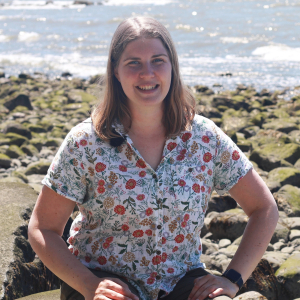
Barnacles and the Heat dome
Amelia Hesketh is a Doctoral Candidate with the Harley Lab at UBC's Biodiversity Research Centre. While researching invertebrates in the intertidal zone before and during the 2021 Heat Dome, Amelia found patterns of survival based on the amount of shade and sun angle where sessile invertebrates were living. How are barnacle populations doing now?
Video Transcript
Hi, I'm Amelia Hesketh and I am a doctoral candidate here at the University of British Columbia and I work with Dr Christopher Harley in the Department of Zoology. My research is broadly on what we call intertidal invertebrates. That's pretty much any animal you see when you go down to a rocky shore, so things like barnacles, mussels, and oysters. I look at how those respond to climate change. In particular high temperatures caused by climate change.
Last year we had a really large heat wave that happened here in Vancouver and also all along the coast of British Columbia. This was the 2021 heat dome. It was just really hot for a period of about five days here in Vancouver and then all along the coast of British Columbia temperatures also got extremely warm relative to historic normals for that time of year. Also while that was happening in June we had some of the lowest tides of the year, so the water was really far out which means that all of the organisms that lived on the beach were baked by the sun for a really long period of time. There was really high mortality that occurred within these different marine populations as a result of that event.
If anyone visited a beach after the heat dome you might have noticed that things smelled really bad which is always a really dead giveaway that a lot of things died on the beach. When myself and other people in my lab would go down to visit our normal field sites we noticed it smelled really bad and then if you went and tried to pry apart say, the little shells on a barnacle, they were floppy and non-responsive. They were, they had just cooked inside of their shells essentially. Not 100% of everything died though. There were definitely patterns in terms of what we saw of where things died. Mortality in the Vancouver area was really high just because temperatures were so high, and the low tide occurred during the hottest part of the day, which is also really important. Out on the outer Coast we definitely saw organisms dying as well. Things like mussels and barnacles, but in in lower numbers just because it didn't get quite as hot out there.
If you looked on a beach itself there was a lot of really small-scale variation in the mortality patterns that you were seeing. Things we noticed were on south-facing surfaces, which because we're in the northern hemisphere southern facing surfaces typically get warmer when you think about rock temperatures, had much higher proportions of dead barnacles and muscles than a surface that was north facing. Similarly if a surface of the rock was really flat it meant that it was receiving sunlight and solar irradiance for a larger proportion of the day then if a surface was more vertical, because then it's getting shaded for part of the day. We noticed that, sort of, the slope of the beach as well as which direction the rock was facing really determined how at risk something was of dying during that time.
During the heat dome, in addition to doing that sort of road trip survey technique, I also had an experiment actually out in Victoria to look at how temperatures influenced barnacles and the little critters that live in the cracks and crevices of those barnacles. I had these plastic shades over top, essentially like a little umbrella, almost over top of barnacle beds in some areas and then no shade in other areas to try and manipulate temperature and that was actually out during the heat dome. That experiment told me that; one, the high temperatures from the heat dome definitely were responsible for the mortality of those organisms; and two, it also told me that shading really mattered.
Algae in the intertidal zone, which are seaweeds, provide cover for the things that live underneath them. The the algae will absorb water and they form this almost wet towel over top of barnacle and mussel beds. One thing we noticed is that barnacles that were underneath that algal canopy were typically less affected in terms of mortality than barnacles that were entirely bare and devoid of algae, and exposed to the sun during that time.
One of the big questions that we had as a lab coming into this year is, how are these different intertidal communities recovering from that heat dome, because we didn't have another large-scale event that immediately followed it. There's been time for the community to sort of get its feet back under it and for reproduction to occur. One thing that's encouraging to see this year is that there are just so many baby barnacles here in Vancouver. If you go down to a beach right now you'll see lots of tiny little barnacles that just have come in after the heat dome. They're less than a year old and that tells me that while the community was really strongly affected there is a chance for it to recover, particularly if we don't have another heat dome like that this year. It means that the community will only begin to sort of mature even more as we go forward.